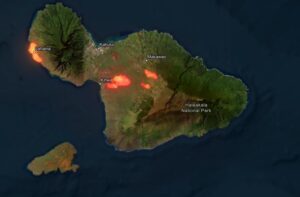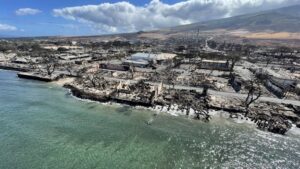What Happened
The island of Maui, Hawaii was the unfortunate victim to catastrophic wildfires on August 8, 2023. Sources and authorities say that throughout the day and night of August 8, several brush fires were ignited all over the island of Maui including the towns of Lahaina, Kula and in upcountry Maui. The climate conditions of the island caused the fires to move rapidly and uncontrollably, leading to the worst wildfire disaster in the United States for over a century.
Conditions on the island for the previous months had created a dangerously high chance of fire. As a result of Hurricane Dora passing to the South of the island, Maui was experiencing sustained winds of 50mph and gusts of up to 90 mph. The island had also been amid a drought spanning back to May of 2023, and had sustained low humidity during this time. These conditions amplified the effects of the fires. Once they started, there were prime ignition materials and conditions to spread the blaze uncontrollably throughout the island, leading to horrific destruction.
On August 7, the National Weather Service had issued a Red Flag Warning for fire danger for Maui as a result of the dry conditions and high winds. Early in the morning on August 8, power outages were being reported and the first brush fire was reported near Kula, Maui. By 5am, Hawaiian Electric reported that they were responding to power outages and downed electrical wires and poles around Lahaina. Shortly after, by 6:30am, a brush fire had broken out near Lahaina, leading to some evacuation of the area. Fire authorities had reportedly contained this fire by 9:00am.
reported and the first brush fire was reported near Kula, Maui. By 5am, Hawaiian Electric reported that they were responding to power outages and downed electrical wires and poles around Lahaina. Shortly after, by 6:30am, a brush fire had broken out near Lahaina, leading to some evacuation of the area. Fire authorities had reportedly contained this fire by 9:00am.
Numerous other regions were experiencing power outages due to downed power lines, and by the afternoon more than 12,000 people were without power. Hawaiian Electric was responding to over 30 downed poles all over the island, and unconfirmed reports state fires were caused by falling power lines. By 4:45pm, the Lahaina brush fire flared up again, this time uncontrollably and engulfed the town of Lahaina. The fire moved so rapidly that fire authorities could not control it and the fire forced some residents to escape into the ocean to avoid the blazes where they had to be rescued by the coast guard.
The result was complete destruction of the town of Lahaina, and as of August 16, more than 100 people have been found dead, and thousands of structures were damaged or destroyed. Over $16 billion in total damage and economic loss is being reported. Governor Josh Green has declared a state of emergency in the wake of what he described as a “fire hurricane.”
Potential Cause
While it remains unclear what the cause was, many sources are pointing towards Hawaiian Electric and their failure to maintain safe infrastructure and failure to implement mitigation methods as the cause of the fires. In fact, A class action lawsuit was filed the weekend after the fires, asserting that the power should have been shut down by Hawaiian Electric and that regulatory laws that require maintenance of equipment by the electric company were not followed.
Hawaiian Electric is responsible for more than 95% of the state’s overall electricity. However, their infrastructure consisted of old dry wooden poles and wiring that were uninsulated and teeming with vegetation. Further, Hawaiian Electric failed to maintain any form of “public power shutoff plan” as is commonly implemented in numerous other states where wildfires are prevalent, such as in California.
A public power shutoff plan is a mitigation method that involves intentionally ceasing the flow of electricity to areas where large winds can spark flames. Documentation shows that Hawaiian Electric was aware that this strategy was effective, however they chose to not implement this strategy instead saying they were focusing on hardening their infrastructure and managing vegetation. A former energy commissioner for Maui stated that the utility company was aware of the need for a shut-down system, and that they needed to bury power lines to prevent wildfires, as they had had a “number of close calls in the past.”
“The earliest fire reported by Maui County officials was described as a ‘brush fire’ in the Olinda Road area of Kula, a town in the island’s Upcountry region. Security camera footage at the Maui Bird Conservation Center was captured on Monday, August 7, at 10:47 p.m., which shows an explosion and flash of light, followed by what is obviously a brush fire, appeared on Instagram recently. See HERE. According to the Washington Post, at that exact moment, 10 sensors in Makawao, a small, rural town in the East Maui region of Upcountry — where the Conservation Center is located — recorded a significant incident in Hawaiian Electric’s grid, according to data from Whisker Labs, a company that uses an advanced sensor network to monitor grids across the United States. However, this fire in Makawao was the first of several reported on Maui, but this is the first time an electrical malfunction caught on video has coincided with data confirming that Hawaiian Electric’s power system experienced a major meltdown at the exact same moment. All of this simply adds to the mounting pile of evidence that Hawaiian Electric’s utility equipment was responsible for sparking multiple fires. The Makawao fire was not the fire that destroyed Lahaina, but it was one of several fires which started on August 7 by what appears to be equipment failure on the part of the electric utility.” https://www.washingtonpost.com/climate-environment/2023/08/15/maui-fires-power-line-cause/
Electric’s grid, according to data from Whisker Labs, a company that uses an advanced sensor network to monitor grids across the United States. However, this fire in Makawao was the first of several reported on Maui, but this is the first time an electrical malfunction caught on video has coincided with data confirming that Hawaiian Electric’s power system experienced a major meltdown at the exact same moment. All of this simply adds to the mounting pile of evidence that Hawaiian Electric’s utility equipment was responsible for sparking multiple fires. The Makawao fire was not the fire that destroyed Lahaina, but it was one of several fires which started on August 7 by what appears to be equipment failure on the part of the electric utility.” https://www.washingtonpost.com/climate-environment/2023/08/15/maui-fires-power-line-cause/
What Next
Matthiesen, Wickert & Lehrer S.C. is currently working with our Hawaii local counsel and experts to investigate the case further. We hope to better understand the scope of the fires and investigate all potential causes for the catastrophe. Please contact Ashton Kirsch at akirsch@mwl-law.com with any questions you may have or referrals surrounding the Hawaii Wildfires and we will work with you to provide more insight into these claims and events.
Ashton T. Kirsch is an insurance litigation attorney and shareholder with the law firm of Matthiesen, Wickert & Lehrer, S.C. Ashton has been with MWL’s Hartford office since 2015, concentrating his practice on litigation of subrogation cases involving large loss casualty, commercial auto, transportation and cargo, and workers’ compensation. He has built and grown the MWL commercial auto and cargo/transportation group into the thriving sector of our firm’s subrogation practice.
Benjamin C. Bauman is a litigation attorney with Matthiesen, Wickert & Lehrer’s Hartford, Wisconsin office. He is licensed to practice in Wisconsin. His practice focuses on workers’ compensation, property, and automobile subrogation cases. Benjamin graduated from University of Wisconsin-Madison, where he received a B.A. in Economics and Spanish and received his law degree from Marquette University in Milwaukee, Wisconsin, during which time he clerked at the Wisconsin Supreme Court.






